2018 MERCEDES-BENZ CLA lights
[x] Cancel search: lightsPage 31 of 326
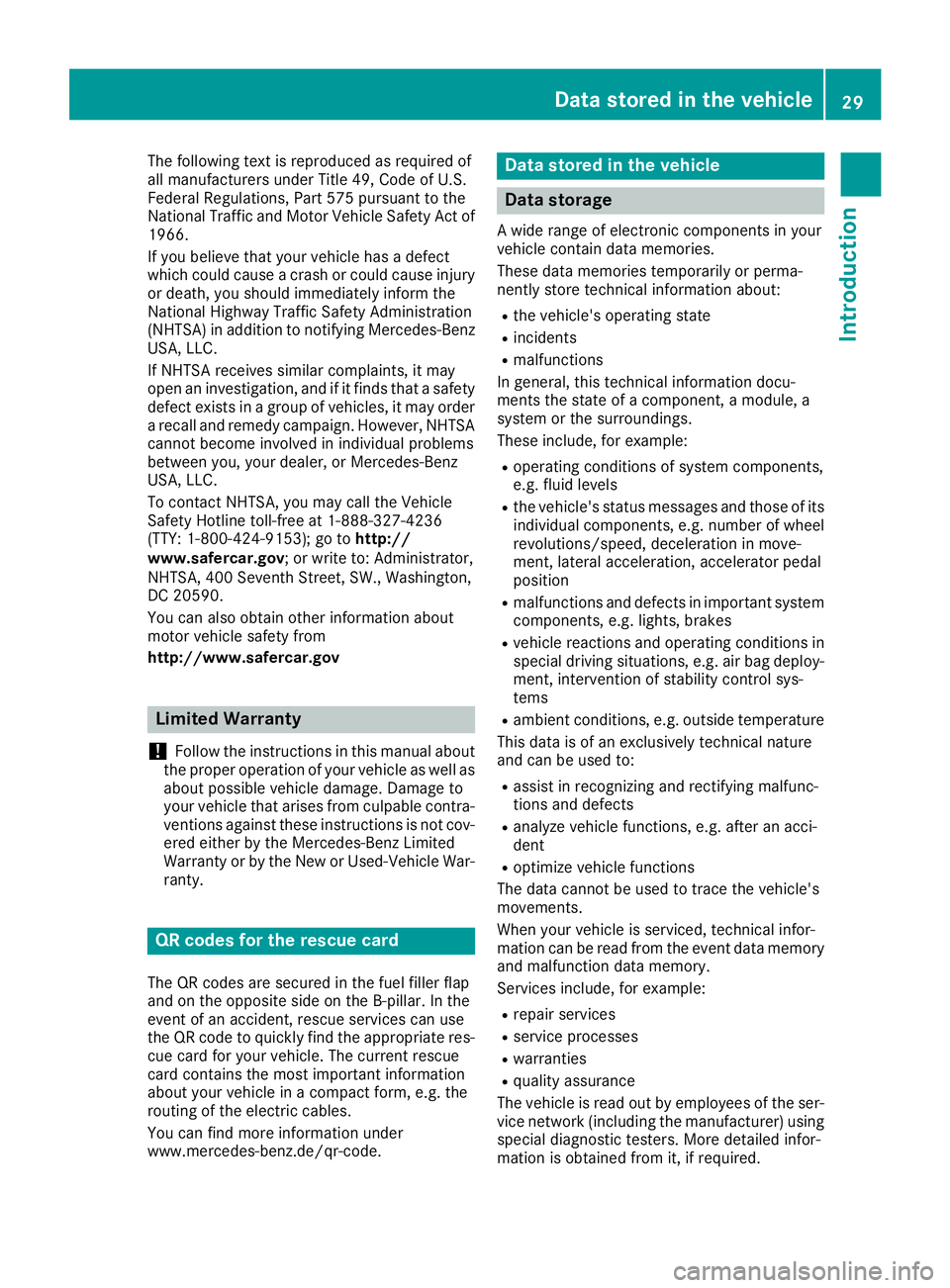
The following text is reproduced as required of
all manufacturers under Title 49, Code of U.S.
Federal Regulations, Part 575 pursuant to the
National Traffic and Motor Vehicle Safety Act of
1966.
If you believe that your vehicle has ad efect
which could cause ac rash or could cause injury
or death, you should immediately inform the
National Highway Traffic Safety Administration
(NHTSA )ina ddition to notifying Mercedes-Benz
USA ,L LC.
If NHTSA receives similar complaints ,itm ay
open an investigation, and if it finds that as afety
defect exists in ag roup of vehicles, it may order
ar ecall and remedy campaign. However, NHTSA
cannot become involved in individual problems
between you, your dealer, or Mercedes-Benz
USA ,L LC.
To contact NHTSA ,y ou may call the Vehicle
Safety Hotlin et oll-free at 1-888-327-4236
(TTY: 1-800-424-9153 ); go to http://
www.safercar.gov ;orw rite to: Administrator,
NHTSA ,4 00 Sevent hS treet, SW., Washington,
DC 20590.
You can also obtain other information about
motor vehicle safety from
http://www.safercar.gov
Limited Warranty
! Follow the instructions in this manual about
the proper operation of your vehicle as well as
about possible vehicle damage. Damage to
your vehicle that arises from culpable contra-
ventions against these instructions is not cov-
ered either by the Mercedes-Benz Limited
Warranty or by the New or Used-Vehicle War-
ranty.
QR codes for the rescue card
The QR codes are secured in the fuel filler flap
and on the opposite side on the B-pillar. In the
event of an accident ,r escue services can use
the QR code to quickly find the appropriate res-
cue card for your vehicle. The current rescue
card contains the most important information
about your vehicle in ac ompact form, e.g. the
routing of the electric cables.
You can find more information under
www.mercedes-benz.de/qr-code. Data stored in the vehicle
Data storage Aw ide range of electronic components in your
vehicle contain data memories.
These data memories temporarily or perma-
nently store technical information about: R
the vehicle's operating state R
incidents R
malfunctions
In general, this technical information docu-
ment st he state of ac omponent, am odule, a
system or the surroundings.
These include, for example: R
operating conditions of system components,
e.g. fluid levels R
the vehicle's status messages and those of its
individual components, e.g. number of wheel
revolutions/speed, deceleration in move-
ment ,l ateral acceleration, accelerator pedal
position R
malfunction sa nd defects in important system
components, e.g. lights, brakes R
vehicle reaction sa nd operating conditions in
special driving situations, e.g. air bag deploy-
ment ,i ntervention of stability control sys-
tems R
ambient conditions, e.g. outside temperature
This data is of an exclusively technical nature
and can be used to: R
assist in recognizing and rectifying malfunc-
tions and defects R
analyze vehicle functions, e.g. after an acci-
dent R
optimize vehicle functions
The data cannot be used to trace the vehicle's
movements.
When your vehicle is serviced, technical infor-
mation can be read from the event data memory
and malfunction data memory.
Services include, for example: R
repair services R
service processes R
warranties R
quality assurance
The vehicle is read out by employees of the ser-
vice network (including the manufacturer) using
special diagnostic testers. More detailed infor-
mation is obtained from it, if required.Data stored in the vehicle 29
Introduction Z
Page 43 of 326

Restraint system warnin gl ampThe functions of the restraint system are
checke da fte rt he ignition is switched on and at
regular interval sw hile the engine is running.
Therefore, malfunctions can be detected in
goo dt ime.
The �u restraint system warning lamp on the
instrument cluster lights up when the ignition is
switched on. It goe so ut no later than af ew sec-
onds afte rt he vehicl eiss tarted. The compo-
nents of the restraint system are in operational
readiness.
Am alfunction ha so ccurred if the �u restraint
system warning lamp: R
doe sn ot light up afte rt he ignition is switched
on R
doe sn ot go ou ta fte raf ew seconds with the
engine running R
lights up agai nw hile the engine is running
G WARNING
If the restraint system is malfunctioning,
restraint system components may be trig-
gered unintentionally or may not deplo ya s
intended during an accident. Thi sc an affect
for exampl et he Emergency Tensioning
Device or the ai rb ag .T hi sp oses an increased
ris kofi njury or eve nf ata li njury.
Have the restraint system checke da nd
repaired in aq uali fied specialist worksho pa s
soo na sp ossible.
PASSENGER AI RB AG indicator lamp
PASSENGER AIR BAG ON indicator lamp �C and
PASSENGER AIR BAG OFF indicator lamp �D are
part of the Occupant Classification System
(OCS). The indicator lamps display the statu soft he
front-passenger front ai rb ag .R
PASSENGER AIR BAG ON lights up for 60 sec-
onds ,s ub sequently both indicator lamps are
off (PASSENGER AIR BAG ON and OFF) :t he
front-passenger front ai rb ag is able to deploy
in the event of an accident. R
PASSENGER AIR BAG OFF lights up :t he front-
passenger front ai rb ag is deactivated. It will
then not be deploye dint he event of an acci-
dent.
If the PASSENGER AIR BAG ON indicator lamp is
off, only the PASSENGER AIR BAG OFF indicator
lamp shows the statu soft he front-passenger
front ai rb ag .T he PASSENGER AIR BAG OFF
indicator lamp may be li tc ontinuously or be off.
Depending on the person in the front-passenger
seat, the front-passenger front ai rb ag must
either be deactivated or enabled; see the fol-
lowing points. Yo um us tm ake sure of this both
before and during aj ourney.R
Childre ninac hild restrain ts ystem:
whethe rt he front-passenger front ai rb ag is
enabled or deactivated depends on the instal-
le dc hild restraint system, and the ag ea nd
size of the child .T herefore, be sure to observe
the notes on the "Occupant Classification
System (OCS)" ( Y
page 47 )a nd on "Chil-
dre nint he vehicle" ( Y
page 54). There you
wil l also find instructions on rearward and
forwa rd-facing child restraint systems on the
front-passenger seat. R
Al lo the rp ersons: depending on the classi-
fication of the person in the front-passenger
seat, the front-passenger front ai rb ag is ena-
bled or deactivated ( Y
page 47). Be sure to
observe the notes on "Seat
belts“ ( Y
page 41 )a nd "Ai rb ag s"
( Y
page 45). There yo uc an also find infor-
mation on the correct sea tp osition.
Seat belts
Introduction
Sea tb elts are the most effective means of
restricting the movement of vehicl eo ccupants
in the event of an accident or the vehicl er olling
over. Thi sr educe st he ris kofv ehicl eo ccupants
coming into contact with parts of the vehicle
interio rorb eing ejecte df rom the vehicle. Fur-
thermore ,t he sea tb el th elps to keep the vehicleOccupan ts afety 41
Safety Z
Page 50 of 326
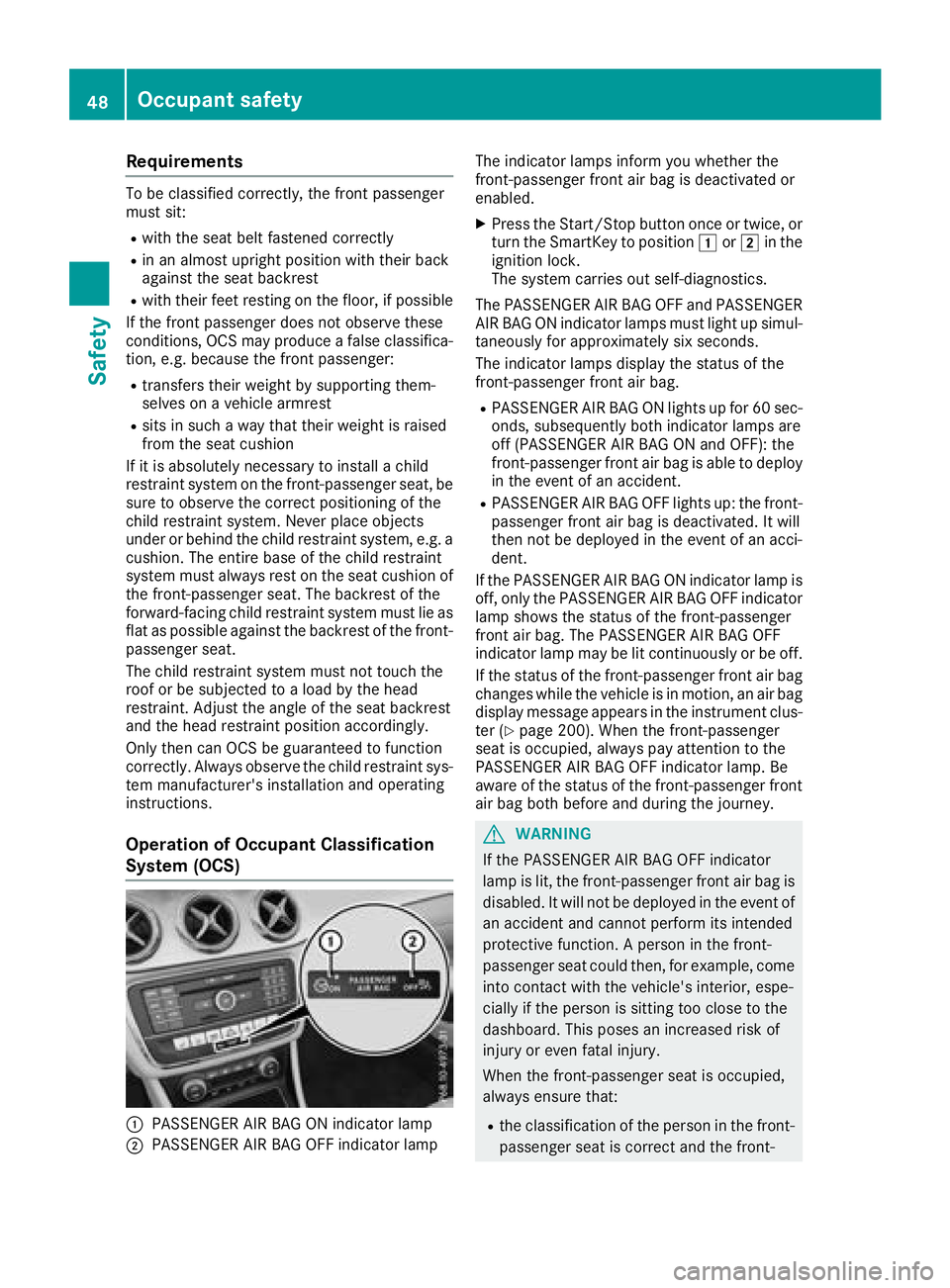
Requirements To be classifie dc orrectly ,t he front passenger
mus ts it:R
with the sea tb el tf astened correctlyR
in an almost upright position with thei rb ac k
against the sea tb ac krestR
with thei rf ee tr esting on the floor, if possible
If the front passenger doe sn ot observe these
conditions ,O CS may produce af alse classifica-
tion, e.g. because the front passenger: R
transfers thei rw eigh tb ys uppo rting them-
selves on av ehicl ea rmrestR
sits in such aw ay that thei rw eigh tisr aised
from the sea tc ushion
If it is absolutely necessary to install ac hild
restraint system on the front-passenger seat, be
sure to observe the correct positioning of the
child restraint system. Neve rp la ce objects
under or behind the child restraint system, e.g. a
cushion. The entir eb as eoft he child restraint
system mus ta lway sr es tont he sea tc ushio no f
the front-passenger seat. The backrest of the
forward-facing child restraint system mus tl ie as
fla ta sp ossible against the backrest of the front-
passenger seat.
The child restraint system mus tn ot touch the
roo forbes ub jecte dtoal oa dbyt he head
restraint. Adjust the angle of the sea tb ac krest
and the hea dr estraint position accordingly.
Only then can OC Sbeg ua ranteed to function
correctly .A lway so bserve the child restraint sys-
tem manufacturer' si nstallation and o perating
i
nstructions.
Operatio nofO cc upant Classification
System (OCS)
�C
PASSENGER AIR BAG ON indicator lamp
�D
PASSENGER AIR BAG OFF indicator lamp The indicator lamps inform yo uw he the rt he
front-passenger front ai rb ag is deactivated or
enabled. X
Press the Start/Sto pb ut ton once or twice, or
turn the SmartKey to position �G or �H in the
ignition lock.
The system carrie so ut self-diagnostics.
The PASSENGER AIR BAG OFF and PASSENGER
AIR BAG ON indicator lamps mus tl ig ht up simul-
taneously for approximately six seconds.
The indicator lamps display the statu soft he
front-passenger front ai rb ag .R
PASSENGER AIR BAG ON lights up for 60 sec-
onds ,s ub sequently both indicator lamps are
off (PASSENGER AIR BAG ON and OFF) :t he
front-passenger front ai rb ag is able to deploy
in the event of an accident. R
PASSENGER AIR BAG OFF lights up :t he front-
passenger front ai rb ag is deactivated. It will
then not be deploye dint he event of an acci-
dent.
If the PASSENGER AIR BAG ON indicator lamp is
off, only the PASSENGER AIR BAG OFF indicator
lamp shows the statu soft he front-passenger
front ai rb ag .T he PASSENGER AIR BAG OFF
indicator lamp may be li tc ontinuously or be off.
If the statu soft he front-passenger front ai rb ag
changes whil et he vehicl eisinm otion, an ai rb ag
display message appears in the instrument clus-
ter ( Y
page 200). Whe nt he front-passenger
sea ti so ccupied, always pa ya ttention to the
PASSENGER AIR BAG OFF indica tor l amp. Be
a
ware of the statu soft he front-passenger front
ai rb ag both before and during the journey.
G WARNING
If the PASSENGER AIR BAG OFF indicator
lamp is lit, the front-passenger front ai rb ag is
disabled. It will not be deploye dint he event of
an accident and canno tp erform its intended
protectiv ef unction. Ap erson in the front-
passenger sea tc ould then, for example, come
into contact with the vehicle's interior, espe-
ciall yift he person is sitting too close to the
dashboard. Thi sp oses an increased ris ko f
injury or eve nf ata li njury.
Whe nt he front-passenger sea ti so ccupied,
always ensure that: R
the classification of the person in the front-
passenger sea ti sc orrect and the front-48
Occupan ts afety
Safety
Page 51 of 326
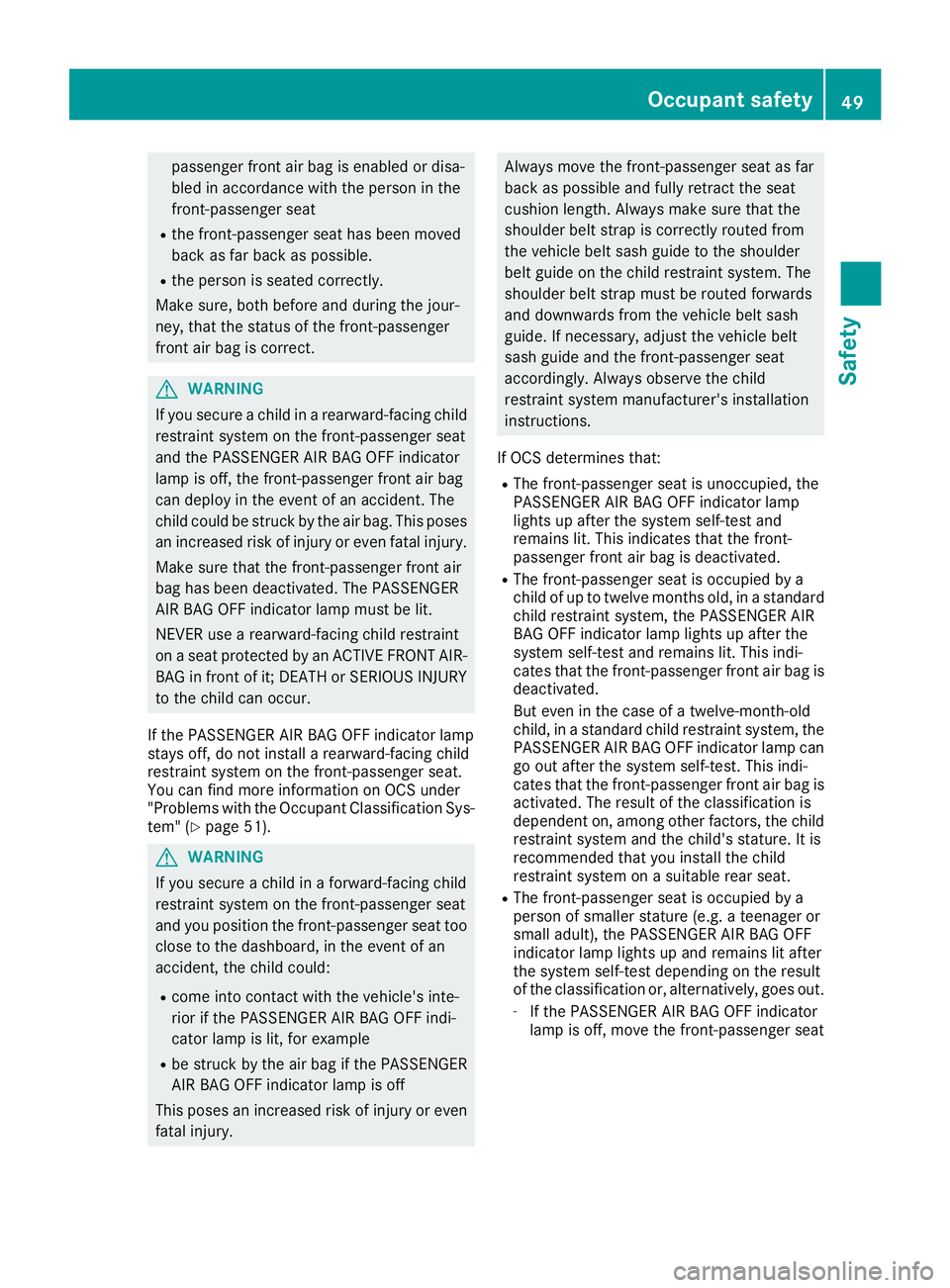
passenger fron ta ir bag is enabled or disa-
bled in accordance with the person in the
front-passenger seat R
the front-passenger seat has been moved
back as far back as possible. R
the person is seated correctly.
Make sure, both before and during the jour-
ney, that the status of the front-passenger
fron ta ir bag is correct.
G WARNING
If you secure ac hild in ar earward-facing child
restraint system on the front-passenger seat
and the PASSENGER AIR BA GO FF indicator
lamp is off, the front-passenger fron ta ir bag
can deploy in the event of an accident. The
child could be struck by the air bag. This poses
an increased risk of injury or even fatal injury.
Make sure that the front-passenger fron ta ir
bag has been deactivated. The PASSENGER
AIR BA GO FF indicator lamp must be lit.
NEVER use ar earward-facing child restraint
on as eat protected by an ACTIVE FRONT AIR-
BA Ginf ron tofi t; DEATH or SERIOUS INJURY
to the child can occur.
If the PASSENGER AIR BA GO FF indicator lamp
stays off, do not install ar earward-facing child
restraint system on the front-passenger seat.
You can find more information on OCS under
"Problems with the Occupant Classification Sys-
tem" ( Y
page 51).
G WARNING
If you secure ac hild in af orward-facin gc hild
restraint system on the front-passenger seat
and you position the front-passenger seat too
close to the dashboard, in the event of an
accident, the child could: R
come int oc ontact with the vehicle's inte-
rior if the PASSENGER AIR BA GO FF indi-
cator lamp is lit, for example R
be struck by the air bag if the PASSENGER
AIR BA GO FF indicator lamp is off
This poses an increased risk of injury or even
fatal injury. Always move the front-passenger seat as far
back as possible and fully retract the seat
cushion length. Always make sure that the
shoulder belt strap is correctly routed from
the vehicle belt sash guide to the shoulder
belt guide on the child restraint system. The
shoulder belt strap must be routed forwards
and downwards from the vehicle belt sash
guide. If necessary, adjust the vehicle belt
sash guide and the front-passenger seat
accordingly. Always observe the child
restraint system manufacturer's installation
instructions.
If OCS determines that: R
The front-passenger seat is unoccupied, the
PASSENGER AIR BA GO FF indicator lamp
lights up after the system self-test and
remains lit. This indicates that the front-
passenger fron ta ir bag is deactivated. R
The front-passenger seat is occupied by a
child of up to twelve months old, in as tandard
child restraint system, the PASSENGER AIR
BA GO FF indicator lamp lights up after the
system self-test and remains lit. This indi-
cates that the front-passenger fron ta ir bag is
deactivated.
But even in the case of at welve-month-old
child, in as tandard child restraint system, the
PASSENGER AIR BA GO FF indicator lamp can
go out after the system self-test. This indi-
cates that the front-passenger fron ta ir bag is
activated. The result of the classification is
dependen to n, among other factors, the child
restraint system and the child's stature. It is
recommended that you install the child
restraint system on as uitable rear seat.R
The front-passenger seat is occupied by a
person of smaller stature (e.g. at eenager or
small adult), the PASSENGER AIR BA GO FF
indicator lamp lights up and remains lit after
the system self-test dependin gont he result
of the classification or, alternatively, goes out. -
If the PASSENGER AIR BA GO FF indicator
lamp is off, move the front-passenger seatOccupant safety 49
Safety Z
Page 53 of 326
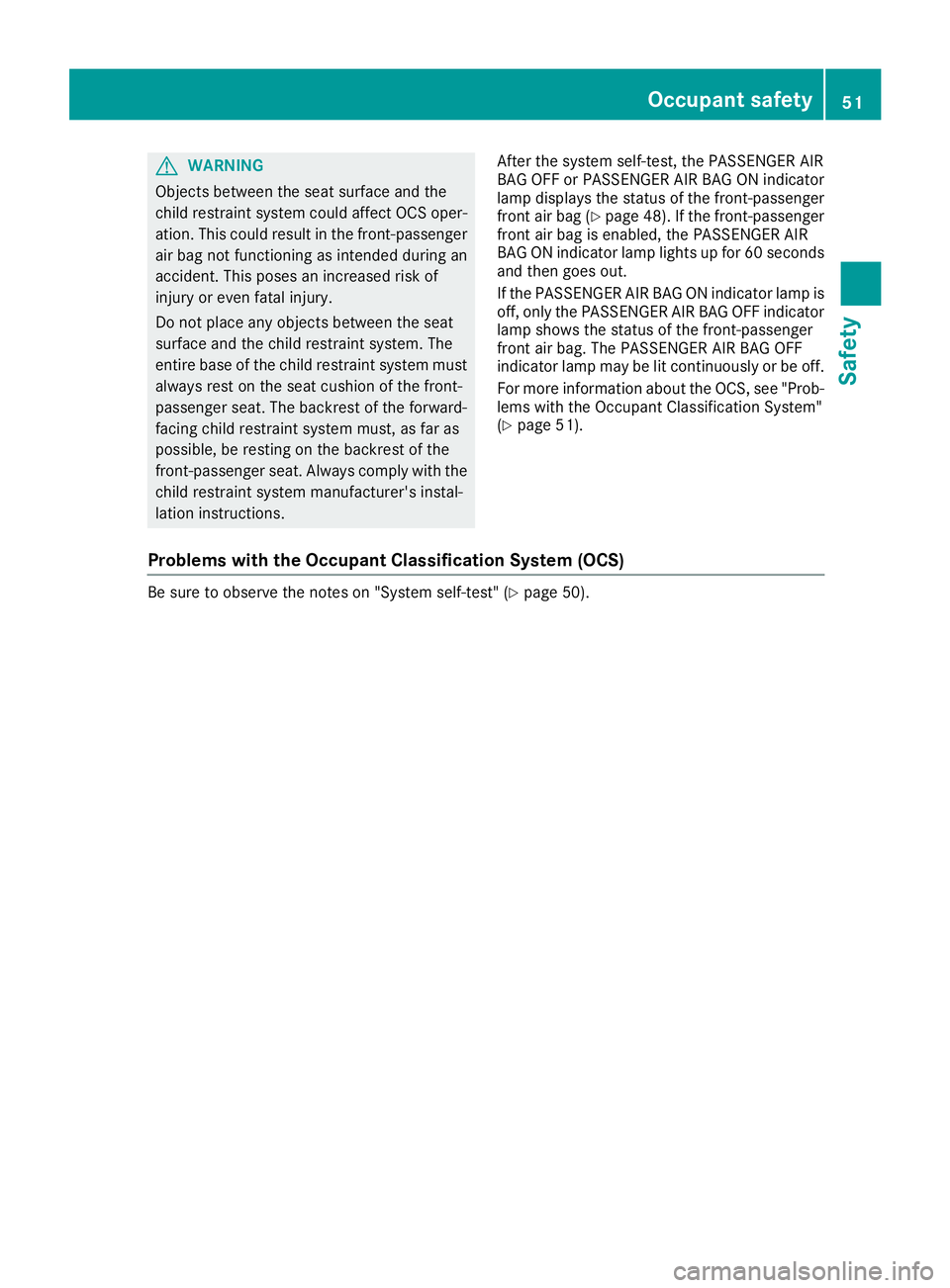
G WARNING
Objects between the seat surface and the
child restraint system coul da ffect OCS oper-
ation. This coul dr esult in the front-passenger
air bag not functioning as intended during an
accident. This poses an increased risk of
injury or even fatal injury.
Do not place any objects between the seat
surface and the child restraint system. The
entire base of the child restraint system must
alway sr est on the seat cushion of the front-
passenger seat. The backrest of the forward-
facing child restraint system must, as far as
possible ,ber esting on the backrest of the
front-passenge rs eat. Always comply with the
child restraint system manufacturer's instal-
lation instructions. After the system self-test, the PASSENGER AIR
BAG OFF or PASSENGER AIR BAG ON indicator
lamp display st he status of the front-passenger
front air bag ( Y
pag e4 8). If the front-passenger
front air bag is enabled, the PASSENGER AIR
BAG ON indicator lamp lights up for 60 seconds
and then goes out.
If the PASSENGER AIR BAG ON indicator lamp is
off, only the PASSENGER AIR BAG OFF indicator
lamp show st he status of the front-passenger
front air bag .T he PASSENGER AIR BAG OFF
indicator lamp may be lit continuously or be off.
For more information about the OCS, see "Prob-
lems with the Occupant Classification System"
( Y
pag e5 1).
Problems with the Occupant Classificatio nS ystem (OCS)Be sure to observe the notes on "System self-test" ( Y
pag e5 0).Occupant safety 51
Safety Z
Page 54 of 326
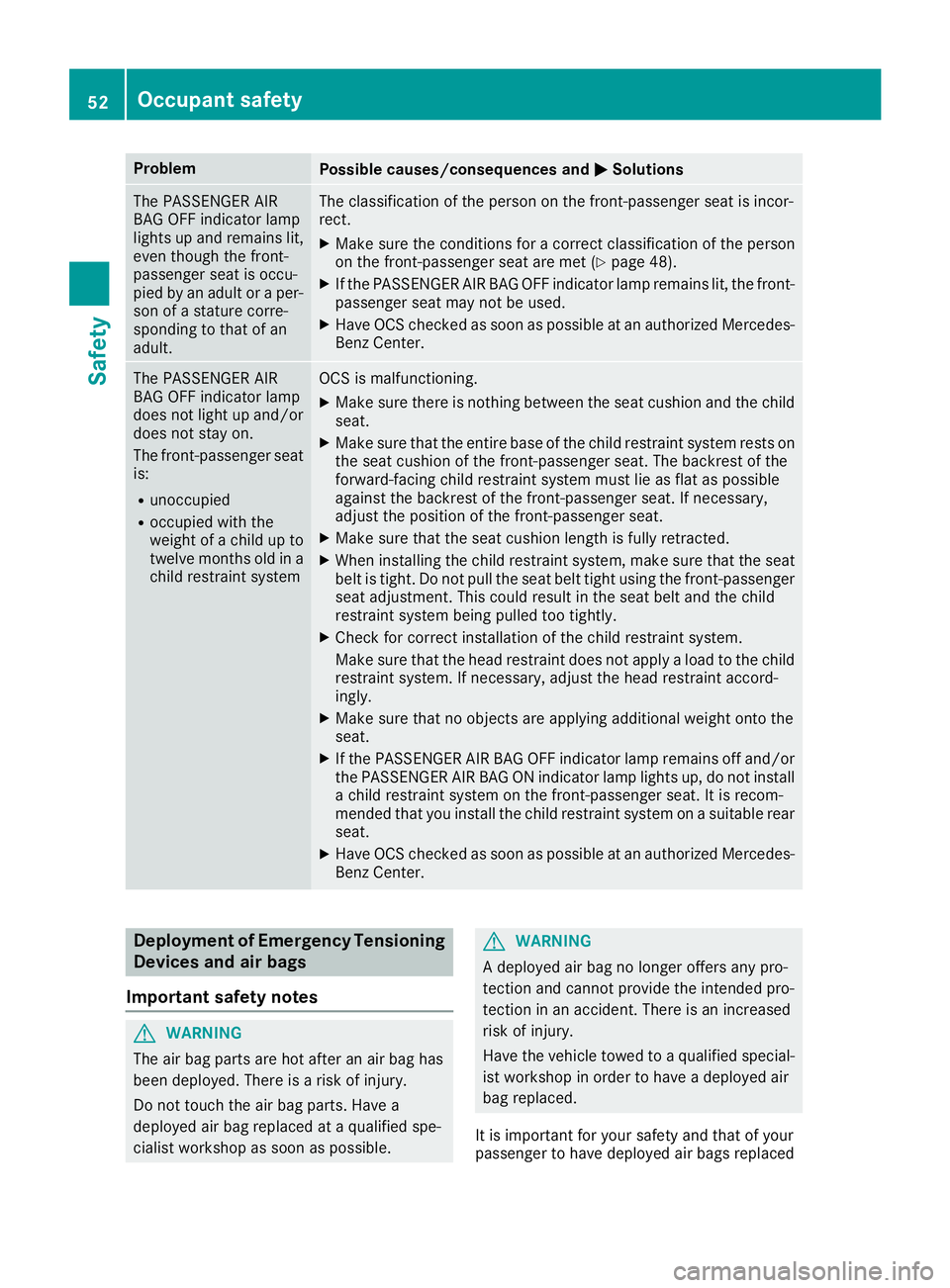
Problem
Possible causes/consequences and �P Solutions
The PASSENGER AIR
BAG OFF indicator lamp
lights up and remains lit,
even though the front-
passenger seat is occu-
pied by an adult or ap er-
son of as tature corre-
sponding to that of an
adult. The classification of the person on the front-passenger seat is incor-
rect. X
Make sure the condition sf or ac orrect classification of the person
on the front-passenger seat are met ( Y
page 48).X
If the PASSENGER AIR BAG OFF indicator lamp remains lit, the front-
passenger seat may not be used. X
Have OCS checked as soon as possible at an authorized Mercedes-
Benz Center.
The PASSENGER AIR
BAG OFF indicator lamp
does not light up and/or
does not stay on.
The front-passenger seat
is: R
unoccupied R
occupied with the
weight of ac hild up to
twelve months old in a
child restraint system OCS is malfunctioning. X
Make sure there is nothin gb etween the seat cushion and the child
seat. X
Make sure that the entire base of the child restraint system rests on
the seat cushion of the front-passenger seat. The backrest of the
forward-facing child restraint system must lie as flat as possible
against the backrest of the front-passenger seat. If necessary,
adjust the position of the front-passenger seat. X
Make sure that the seat cushion length is fully retracted. X
When installing the child restraint system, make sure that the seat
belt is tight. Do not pull the seat belt tight using the front-passenger
seat adjustment .T his could result in the seat belt and the child
restraint system being pulled too tightly. X
Check for correct installation of the child restraint system.
Make sure that the head restraint does not apply al oad to the child
restraint system. If necessary, adjust the head restraint accord-
ingly. X
Make sure that no object sa re applying additional weight onto the
seat. X
If the PASSENGER AIR BAG OFF indicator lamp remains off and/or
the PASSENGER AIR BAG ON indicator lamp lights up, do not install
ac hild restraint system on the front-passenger seat. It is recom-
mended that you install the child restraint system on as uitable rear
seat. X
Have OCS checked as soon as possible at an authorized Mercedes-
Benz Center.
Deployment of Emergency Tensioning
Devices and air bags
Important safety notes
G WARNING
The air bag parts are hot after an air bag has
been deployed. There is ar isk of injury.
Do not touch the air bag parts. Have a
deploye da ir bag replaced at aq ualified spe-
cialist workshop as soon as possible. G WARNING
Ad eploye da ir bag no longer offers any pro-
tection and cannot provide the intended pro-
tection in an accident. There is an increased
risk of injury.
Have the vehicle towed to aq ualified special-
ist workshop in order to have ad eploye da ir
bag replaced.
It is important for your safety and that of your
passenger to have deploye da ir bags replaced52
Occupant safety
Safety
Page 63 of 326

Drivin gs af et ys ystems
Overview of drivin gs af et ys ystemsIn this section ,y ou will fin di nformati on about
th ef ol lowin gd rivin gs afet ys ystems :R
AB S( A nti-lock B rakin g S ystem)
( Y
page 61) R
BA S( B rak e A ssist S ystem) ( Y
page 61)R
Active Brak eA ss is t( Y
page 62 )R
ES P ®
( E lectronic S ta bility P ro gram)
( Y
page 64) R
EB D( E lectroni c B rak ef orce D istribution )
( Y
page 67 )R
ADAPTIV EB RAKE ( Y
page 68 )R
STEE RC ONTROL ( Y
page 68)
Important safet yn otesIf you fail to adapt your drivin gs ty le or if you are
inattentive ,t he drivin gs afet ys ystems can nei-
ther reduce th er is kofana cciden tn or override
th el aws of physics. Driving safet ys ystems are
merely aids designed to assist driving. You are
responsible fo rm aintainin gt he distanc etot he
vehicle in front, fo rv ehicle speed, fo rb raking in
goo dt im e, and fo rs ta yin ginl ane. Always adapt
your drivin gs ty le to suit th ep revailin gr oa da nd
weather condition sa nd maintain as af ed istanc e
from th ev ehicle in front. Drive carefully.
The drivin gs afet ys ystems described only wor k
as effectively as possible when there is ade-
quat ec ontac tb etween th et ir es and th er oa d
surface. Please pay special attention to th e
note sont ir es ,r ecommended minimum tire
tread depths, etc. ( Y
page 288).
In wintr yd rivin gc onditi ons, always use winte r
tires (M+ St ir es )a nd if necessary ,s now chains.
Onl yint hi sw ay will the driving safety systems
describe dint hi ss ection work as effectively as
possible.
ABS (Anti-lock Brakin gS ystem)
General information
ABS regulate sb rake pressure in such aw ay that
the wheels do not lock when yo ub rake. This
allows yo utoc ontinue steering the vehicl ew he n
braking. The �% ABS warning lamp in the instrument
cluster lights up when the ignition is switched
on. It goe so ut when the engine is running.
ABS works from as peed of abou t5m ph
(8 km/h), regardless of road-surface conditions.
ABS works on slippery surfaces, eve nw he ny ou
onl yb rake gently.
Important safety notes
i Observe the "Important safety notes "s ec-
tio n( Y
page 61).
G WARNING
If ABS is faulty ,t he wheels could lock when
braking .T he steerability and braking charac-
teristic sm ay be severely impaired .A ddition-
ally ,f urther driving safety system sa re deac-
tivated .T here is an increased danger of skid-
ding and accidents.
Driv eonc arefully. Hav eA BS checked imme-
diately at aq uali fied specialist workshop.
Whe nA BS is malfunctioning ,o the rs ys tems,
including driving safety systems, will also
become inoperative. Observe the information
on the ABS warning lamp ( Y
page 220 )a nd dis-
play messages which ma ybes hown in the
instrument cluster ( Y
page 192).
Braking X
If ABS intervenes: continue to depress the
brake peda lv igorously unti lt he braking sit-
uatio ni so ver. X
To make af ul lb rake application: depress
the brake peda lw it hf ul lf orce.
If ABS intervene sw he nb raking ,y ou will fee la
pulsing in the brake pedal.
The pulsating brake peda lc an be an indication
of hazardou sr oa dc onditions, and functions as a
reminder to take extra car ew hile driving.
BAS (Brak eA ssis tS ystem)
General information
BAS operates in emergency braking situations.
If yo ud ep ress the brake peda lq ui ckly, BAS
automaticall yb oo sts the braking force ,t hus
shortening the stopping distance.Driving safety systems 61
Safety Z
Page 73 of 326

KEYLESS- GO
Gene ra ln ot esBear in min dt ha tt he engin ec an be started by
any of th ev ehicl eo cc upant sift he re is aS ma rt -
Key in th ev ehicle.
Lockin ga nd unlockingYou can start ,l oc koru nloc kt he vehicl eu sin g
KEYLESS-GO .Todot hi s, you only need carry th e
SmartKey wit hy ou. You can combine th ef unc-
tion sofK EY LESS-GO wit ht ho se of ac onven-
tional SmartKey. Unloc kt he vehicl ebyu sin g
KEYLESS-GO ,f or instance ,a nd loc kitu sin gt he
�7 butto nont he SmartKey.
The driver's door and th ed oor at whic ht he han -
dle is used ,m us tb ot hbec losed. The SmartKey
mus tbeo utside th ev ehicle. Whe nl ocking or
unlocking wit hK EY LESS-GO ,t he distanc e
between th eS ma rtKey and th ec orre sponding
door handle mus tn ot be greate rt ha nt hr ee fee t
(on em eter).
Ac heck whic hp eriodically establishes ar adi o
connection between th ev ehicl ea nd th eS ma rt -
Key determine sw hether av alid SmartKey is in
th ev ehicle. This occurs, for example: R
when starting th ee ng in eR
while drivin gR
when usin gH ANDS-F RE EA CCESSR
when th ee xternal door handles are touchedR
during convenience closin g
X
To unlock th ev ehicle: touch th ei nner sur -
fac eoft he door handle.X
To lock th ev ehicle: touch sensor surfac e �C
or �D . Mak es ur et ha ty ou do no tt ou ch th ei nner
surfac eoft he door handle. X
Convenienc ec losin gf eature: touch
recessed sensor surfac e �D for an extended
period.
Further information on th ec onveni ence clos-
ing feature ( Y
page 83).
X
To unlock th et ru nk lid : pull trunk lid han -
dle �C .
Deactivating and activating If you do no ti nten dtou se th ev ehicl ef or al on -
ger period of time, you can deactivat eK EY LESS -
GO. The SmartKey will then use ver yl ittl ep ower,
thereby conserving battery power. Fo rt he pur-
poses of activation/deactivation ,t he vehicl e
mus tn ot be nearby. X
To deactivate: press th e �7 butto nont he
SmartKey twice in rapi ds uccession .
The battery chec kl amp of th eS ma rtKey
flashes twice briefl ya nd lights up once ,t he n
KEYLESS-GO is deactivated ( Y
page 73).X
To activate: press any butto nont he Smart -
Key.
or X
Inser tt he SmartKey int ot he ignition lock.
KEYLESS-GO and all of it sa ssociated features
are available again .
KEYLESS- GO star tf un ction
Gene ra ln ot es
Bear in min dt ha tt he engin ec an be started by
any of th ev ehicl eo cc upant sift he re is aS ma rt -
Key in th ev ehicle.SmartKey 71
Opening and closing Z